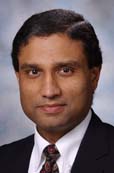Advances in breast and ovarian cancers, acupuncture, latinos contra el cancer
A gene, a protein and breast cancer

Mien-Chie Hung, Ph.D.
Mien-Chie Hung, Ph.D., and his colleagues are hot on the trail of genes and proteins — among them p53 and EZH2 — to understand their role in cancer. Do they block disease development or aid it? How can they be stopped or encouraged?
A bounty-hunter gene: p53
A newly discovered activity of the cancer-fighting gene p53 offers a potential avenue of attack on breast cancer stem cells, thought to play a central role in progression and spread of the disease.
Like a bounty hunter returning escapees to custody, p53 converts organ cells — that change into highly mobile stem cells — back to their original, stationary state.
“Blocking this conversion is important because that change plays an essential role in cancer metastasis,” says Hung, professor and chair of MD Anderson’s Department of Molecular and Cellular Oncology and vice president for basic research.
Reported in the March 2011 edition of Nature Cell Biology.
An essential protein: EZH2
An essential protein for normal stem cell renewal, EZH2 also promotes the growth of breast cancer stem cells when it’s overproduced in those cells.
However, in mouse and lab experiments, Hung and his team discovered that two drugs block the cascade of molecular events and thwart formation of breast tumor-initiating cells.
The team tested five anti-cancer drugs and found that sorafenib, also known as Nexavar®, eliminated more cancer stem cells and blocked tumor formation better than the other four.
An experimental drug, AZD6244, eliminates EZH2-promoted breast cancer stem cells and blocks the formation of precancerous mammospheres.
Reported in the Jan. 18, 2011, edition of Cancer Cell.
Special delivery via ‘good cholesterol’
New research suggests that “good cholesterol” can act as a special delivery vehicle of destruction for cancer.

Anil Sood, M.D.
Synthetic nanoparticles of high-density lipoprotein (HDL) loaded with small interfering RNA (siRNA) to silence cancer-promoting genes selectively shrunk or destroyed ovarian cancer tumors in mice.
“RNA interference has great therapeutic potential, but delivering it to cancer cells has been a problem,” says Anil Sood, M.D., the study’s senior author, co-director of MD Anderson’s Center for RNA Interference and Non-Coding RNA and co-director of its Blanton-Davis Ovarian Cancer Research Program.
“Combining siRNA with HDL provides an efficient way to get these molecules to their targets. This study has several important implications in the ability to fight certain cancers.”
Reported by a team of researchers from MD Anderson and the University of North Texas Health Science Center in Fort Worth in the April 2011 edition of Neoplasia.
Can acupuncture help prevent dry mouth?
Xerostomia (dry mouth) affects more than 80% of head and neck cancer patients undergoing radiation. This side effect makes it difficult to speak, eat, sleep and often results in taste changes.

Lorenzo Cohen, Ph.D.
To see if it can be prevented when acupuncture is part of a patient’s treatment regimen, researchers at MD Anderson have received a $2.7 million grant from the National Cancer Institute.
“Previous studies, including research conducted at MD Anderson, examined acupuncture to treat xerostomia after it developed,” says funding recipient Lorenzo Cohen, Ph.D., professor in MD Anderson’s departments of General Oncology and Behavioral Science, and director of the Integrative Medicine Program.
“Our new research is unique because we’re incorporating acupuncture during radiation to see if we can prevent the condition in the first place, and, should it develop, try to diminish the severity.”
This research is in collaboration with MD Anderson’s sister institution, Fudan University Shanghai Cancer Center in Shanghai, China.
Texas Latinos focus of new network
To reduce cancer-related health disparities among Texas Latinos, the National Cancer Institute has awarded a $4 million, five-year grant to create a Texas regional Community Networks Program Center, Latinos Contra El Cancer.

David Wetter, Ph.D.
The center is a joint project of MD Anderson and The University of Texas Health Science Center at Houston School of Public Health. It will engage the community to develop effective and culturally appropriate cancer prevention and control programs among Latinos.
The goal is to develop and evaluate innovative approaches to the three leading behavioral risk factors for cancer: smoking, poor diet and physical inactivity.
“The number of Latino cancer cases is projected to increase dramatically in the next several decades. The center’s efforts are designed to build capacity in the Latino community throughout the state to deliver evidence-based cancer prevention and control policies, as well as interventions,” says David Wetter, Ph.D., professor and chair of MD Anderson’s Department of Health Disparities Research.



















